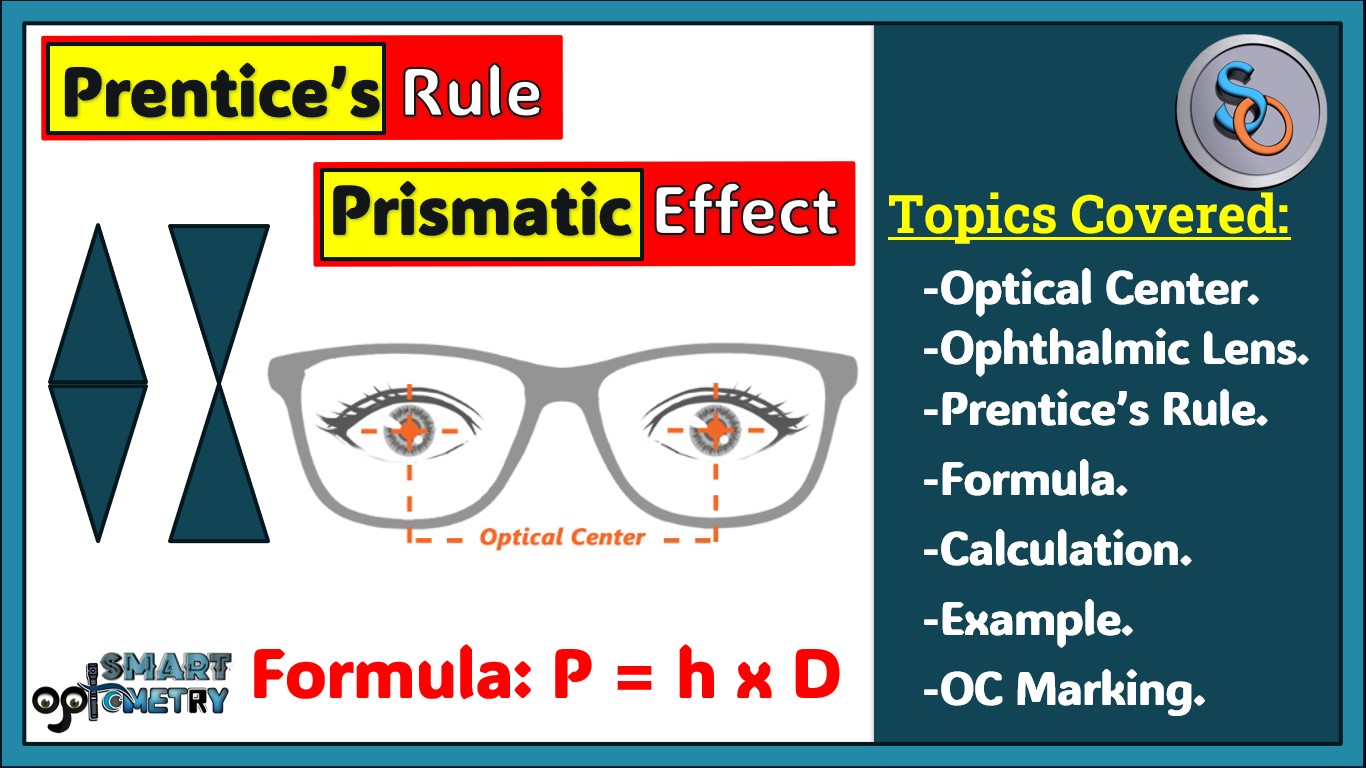Introduction:
When light rays pass through the optical center of the ophthalmic lens, it does not bend, but travels straight through. But if light rays pass through other point of ophthalmic lens, then it will bend and will create prismatic effect.
What is optical center & why rays don’t bend when pass through the optical center?
- To understand this question first we have to understand, How does ophthalmic lenses are made:
Formation of Ophthalmic Lenses:
- Ophthalmic lenses are made up of prisms. Specifically:
- When two prisms are joined apex to apex, a concave lens is formed.
- When two prisms are joined base to base, a convex lens is created.
What is Optical Center:
- The junction (apex to apex or Base to Base) where prisms meet in the lens construction is known as the optical center. This point is characterized by the absence of prismatic effect, meaning there is no deviation of light rays.
Why do rays not bend when pass through optical Centre:
- As the in optical center there is no prism, so if any ray pass through optical center, then ray will pass without bending.
- When light rays pass through any other point on the ophthalmic lens, they encounter a prismatic effect. The deviation or bending of light at these points creates the desired corrective effect of the lens but does not occur at the optical center.
How is the prismatic effect created when the optical center is decentered?
- In the design and fitting of spectacles, the lenses are typically positioned so that the optical center (OC) aligns precisely with the center of the pupil or the visual axis of the eye.
- This alignment ensures that no prismatic effect is produced, providing clear and accurate vision.
- However, when the optical center is decentered, a prismatic effect is introduced, causing the light to bend differently based on the lens type and the direction of decentration.
1. Decentration of Minus Lenses and its prismatic Effects:
Decentered Nasally:
- Nasally Decentered Minus lens creates a Base Out prism effect.
- Due to Base Out prismatic effect, central rays focus temporal to fovea and eye moves inward so that rays focus on the fovea.
Decentered Temporally:
- Temporally Decentered Minus lens creates a Base In prism effect.
- Due to Base In prismatic effect, central rays focus nasal to fovea and eye moves outward so that rays focus on the fovea.
Decentered Upward:
- A Upword decentration of minus lens will create Base Down prismatic effect.
- Due to Base Down prismatic effect, rays focus downward to fovea and eye moves upward so that rays focus on the fovea.
Decentered Downward:
- A Downward decentration of minus lens will create Base Up prismatic effect.
- Due to Base Up prismatic effect, rays focus upward to fovea and eye moves downward so that rays can focus on the fovea.
2. Decentration of Plus Lenses and its prismatic Effects:
Decentered Nasally:
- Nasally Decentered Plus lens creates a Base In prism effect.
- Due to Base In prismatic effect, central rays focus nasal to fovea and eye moves outward so that rays focus on the fovea.
Decentered Temporally:
- Temporally Decentered Plus lens creates a Base Out prism effect.
- Due to Base Out prismatic effect, central rays focus temporal to fovea and eye moves inward so that rays focus on the fovea.
Decentered Upward:
- A Upword decentration of Plus lens will create Base Up prismatic effect.
- Due to Base Up prismatic effect, rays focus upward to fovea and eye moves downward so that rays can focus on the fovea.
Decentered Downward:
- A downward decentration of Plus lens will create Base Down prismatic effect.
- Due to Base Down prismatic effect, rays focus downward to fovea and eye moves upward so that rays focus on the fovea.
Can we calculate the amount of prismatic effect created by a decentered ophthalmic lens?
- Yes, we can calculate the amount of prismatic effect created by a decentered lens using Prentice’s rule.
- According to Prentice’s rule, the prismatic effect induced by the decentration of a lens depends on the dioptric power of the lens and the distance the optical center (OC) is displaced.
- The formula for Prentice’s rule is:
P = h × D
Where:
- P = Amount of prismatic effect (in Prism Diopters, PD)
- D = Dioptric power of the lens
- h = Displacement of the optical center (in centimeters)
Example:
- If a lens has a power of +2.00 D and the OC is displaced by 6 mm, we can calculate the induced prismatic effect as follows:
Given:
- D = + 2.00
- h = 6 or 0.60 cm
Using Prentice’s rule:
- P = h × D
- P = 0.60 × 2.00
- P=0.60 × 2.00
- P = 1.2 Prism Diopters (PD)
So, a lens has a power of +2.00 D and the OC is displaced by 6 mm will create 1.2 PD prismatic Effect.
As decentered optical centred create prismatic effect, can we use decentered ophthalmic lens as prescription prism?
- Yes, decentered ophthalmic lenses can be used to create a prescribed prismatic effect.
- When a lens prescription includes a specified amount of prism, the optical center is intentionally decentered so that the desired prism correction is achieved at the point of major importance, which aligns with the wearer’s visual axis.
Example:
- If a lens prescription calls for 2 Prism Diopters (PD) of prismatic effect and the lens power is +3.00 D, we can calculate the necessary decentration using Prentice’s rule.
Given:
- D= +3.00 D
- P= 2 PD
Using Prentice’s rule:
- P= h × D
- 2 = h × 3
- h = 2/3
- h = 0.67 cm
Therefore, to achieve a 2 Prism Diopter (PD) prismatic effect with a +3.00 D lens, the optical center needs to be decentered by 0.67 cm (or 6.7 mm).
Marking the Optical Center:
- When fitting ophthalmic lenses, precise marking of the optical center is essential to ensure that the lenses align correctly with the patient’s visual axis.
- This process involves several steps to accurately position the optical center relative to the pupil center.
- Here’s a step-by-step guide:
1. Adjust the Frame:
- Adjust the nose pads, frame height, pantoscopic tilt, and ensure the frame is straight on the patient’s face for optimal fit and comfort.
2. Positioning the Fitter and Patient:
- The fitter positions himself at the same level as the patient.
- The fitter’s right eye should be directly in front of the patient’s left eye and vice versa.
3. Aligning the Frame:
- The fitter tilts the patient’s chin until the frame front is perpendicular to the floor.
4. Marking the Pupil Center for the Left Eye:
- The patient fixates on the fitter’s right eye with both eyes open.
- The fitter marks the location of the pupil center on the patient’s left lens with a marker, making a dot or a + mark.
5. Marking the Pupil Center for the Right Eye:
- The patient then fixates on the fitter’s left eye with both eyes open.
- The fitter marks the location of the pupil center on the patient’s right lens with a marker, making a dot or a + mark.
6. Superimposing the Marks with the Optical Center:
- These marked dots or + marks are now used to align the optical center of the ophthalmic lenses.
- The optical center of each lens is superimposed with the marked pupil center, ensuring that the lenses are properly aligned with the patient’s visual axis.
- Check Our Courses: Ophthalmic Instrumentation, Clinical Refraction, Contact Lens, Binocular Vision, Dispensing Optics, MCQs in Optometry
- Download our App “Optometry Notes & MCQs” from Google Play Store.




